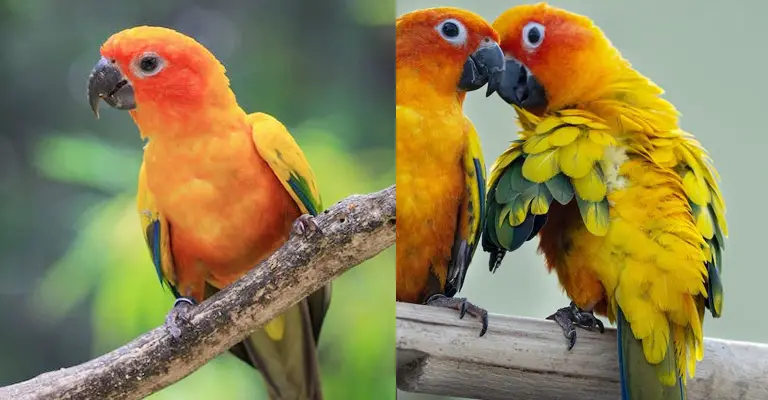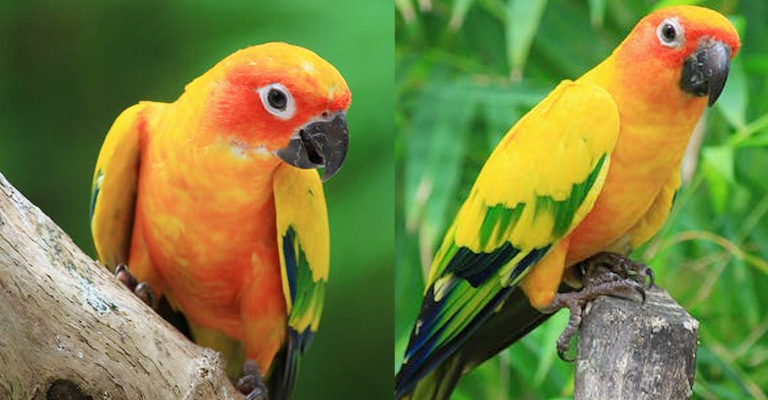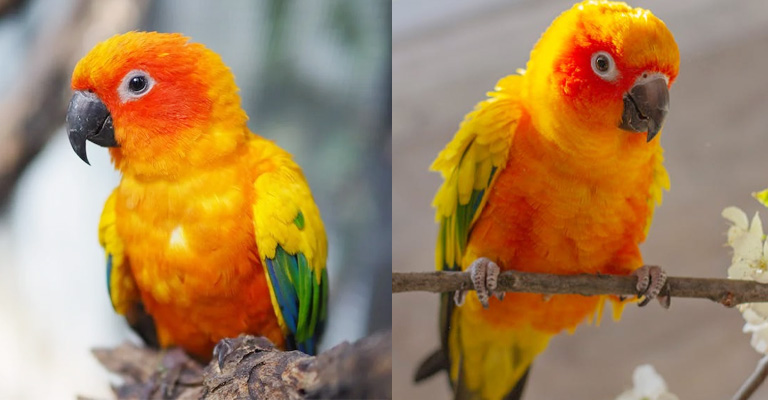When comparing Jenday Conures and Sun Conures, it’s important to explore their distinct characteristics and understand the differences between these two popular pet bird species.
Both Jenday Conures (Aratinga jandaya) and Sun Conures (Aratinga solstitialis) are colorful, charismatic parrots native to South America.
While they share certain similarities, such as their vibrant plumage and playful nature, they also have notable differences in terms of appearance, behavior, and care requirements.
By examining these factors, we can gain a better understanding of the unique traits and considerations associated with each species, aiding potential owners in making an informed choice when selecting a pet bird.
However, in this blog, we’ll discuss the common factors of the basic differences between Jenday Consure and Sun Conure. Hopefully, you will find them helpful.

Physical Appearance
The first thing you need to notice while identifying a Jenday Conure and Cnure is looking at their physical appearance. Here are the points you need to check while identifying them.
Coloration
One of the most striking differences between Jenday conures and sun conures lies in their wing coloration. Jenday conures possess green wings, creating a lovely contrast against their body feathers.
On the other hand, sun conures showcase primarily yellow wings, which contribute to their stunning and eye-catching appearance. While both species have colorful plumage, jenday conures exhibit a more muted coloration overall, featuring shades of green, orange, and black feathers.
In contrast, sun conures boast vibrant and vivid orange and yellow plumage throughout their bodies.
Facial Feathering
Another distinct feature that sets jenday conures and sun conures apart is their facial feathering. Jenday conures sport a black mask that extends from their eyes to their beaks.
This black mask adds a touch of drama to their appearance and enhances the contrast with their vibrant body colors. On the other hand, sun conures have a larger white patch surrounding their eyes, giving them a unique “eyeliner” look.
This white patch further accentuates their expressive and lively faces, adding to their charm.
The coloration and facial feathering are key elements that differentiate jenday conures from sun conures. While jenday conures feature green wings and a black mask, sun conures showcase primarily yellow wings and a white patch around their eyes.
These distinct physical characteristics contribute to the unique beauty and charm of each species, making them easily distinguishable from those familiar with their appearances.
Size and Weight

The next thing you need to check is their size and weight. Here are a few things you can check to differentiate these two species.
Comparison of Average Length and Weight for Jenday and Sun Conures
In terms of length, jenday conures, and Sun conures share a similar size range. On average, they measure around 12 inches (30 cm) from head to tail. However, when it comes to weight, jenday conures tend to be slightly larger and heavier than sun conures.
Jenday conures can weigh between 120 to 150 grams, while sun conures typically weigh around 110 to 130 grams. These weight variations are not substantial and are generally within a close range.
Highlighting the Slight Differences in Size Between the Two Species
While the differences in size between jenday conures and sun conures are minimal, they can still be noticeable upon close observation. Jenday conures may appear slightly larger in body structure, with a broader chest and a more robust overall physique compared to sun conures.
In contrast, sun conures might exhibit a slightly more compact and streamlined body shape.
It’s important to keep in mind that individual variation exists within each species, and there may be slight deviations from the average size and weight mentioned.
These differences, however subtle, contribute to the unique characteristics of jenday conures and sun conures and can be helpful in distinguishing between the two species.
While jenday conures and sun conures share a similar length, jenday conures tend to be slightly larger and heavier. Their differences in size, although modest, can be discerned through careful observation, particularly in body structure and overall physique.
Range and Habitat

Also, you need to check the range and habitats so that you can find more differences between these two species.
Native Regions of Jenday and Sun Conures
Jenday conures are native to northeastern Brazil, specifically the regions of Bahia, Espirito Santo, and Rio de Janeiro. These areas are characterized by a tropical and subtropical climate, with diverse ecosystems ranging from coastal plains to rainforests.
Jenday conures are well adapted to this region and are often found in various habitats, including forests, woodlands, savannas, and even urban areas.
Sun conures are found in northeastern South America, including Brazil, Guyana, Suriname, and French Guiana. Within these regions, they inhabit various habitats such as rainforests, palm groves, and forest edges.
They are particularly associated with lowland forests and areas near rivers or wetlands. Sun conures are known for their adaptability and can also be found in cultivated areas, orchards, and even urban environments.
Overview of Their Respective Habitats
Jenday conures thrives in a range of habitats, including tropical forests, woodlands, and even semi-open areas. They are well adapted to the diverse landscape of northeastern Brazil and can be found in both coastal and inland regions.
These conures are known to form flocks and are often seen in groups, roosting in trees and foraging for food in the canopy. They are comfortable in various types of vegetation and can adapt to human-altered landscapes.
Sun conures, on the other hand, exhibit a strong preference for lowland rainforests and adjacent habitats. They are commonly found in dense foliage, utilizing the canopy for feeding, nesting, and social interactions.
Sun conures are highly social birds and often form large flocks, especially during the breeding season. They rely on the abundance of fruits, seeds, and nectar available in their habitat for sustenance.
Vocalizations
Even if you can’t see the bird, you can identify them just by listening to their vocals. In this case, you need to remember the following facts.
Similarities in Loud and Vocal Nature
Both jenday conures and sun conures are highly vocal birds and can produce a wide range of vocalizations. They have powerful voices and are capable of emitting loud calls, squawks, and screeches.
These vocalizations serve various purposes, including communication within their flock, establishing territory, expressing emotions such as excitement or alarm, and attracting mates.
Their loud vocal nature is a natural adaptation for survival and social interaction in their native habitats.
Potential Individual Variations in Vocalizations
While jenday conures and sun conures share a general tendency towards being loud and vocal, it’s important to note that individual variations in vocalizations can occur.
Each bird may have its own unique repertoire of sounds and calls, influenced by factors such as genetics, social interactions, and environmental stimuli.
Some conures may develop distinct vocalizations or mimic sounds they hear in their surroundings, including human speech or household noises.
It’s worth mentioning that the frequency and intensity of vocalizations can also vary among individuals. Some conures may be more vocal and prone to frequent vocalizations, while others may be relatively quieter.
These variations can be influenced by factors such as age, hormonal cycles, socialization, and individual personality.
Therefore, while both jenday conures and sun conures are known for their loud and vocal nature, it’s important to understand that each bird may exhibit its own unique vocalization patterns and tendencies.
Building a strong bond with the bird and observing its individual vocalizations can provide insights into its communication and emotional states.
Care and Maintenance
If you have a pet bird and that is either a Sun conure or a Jenday conure, you must be aware of their proper maintenance and care. Here are the things you need to consider.
Diet
Both jenday conures and sun conures have similar dietary requirements. Their diet should consist of a variety of fresh fruits, vegetables, and leafy greens.
Offer a mix of nutritious foods such as apples, bananas, berries, carrots, broccoli, spinach, and kale. Additionally, provide a high-quality pellet or seed mix formulated specifically for conures to ensure they receive essential nutrients.
It’s important to avoid feeding them toxic foods like avocado, chocolate, caffeine, alcohol, and foods high in salt or sugar. Fresh, clean water should always be available, and food and water dishes should be cleaned regularly to maintain hygiene.
Housing Requirements
Jenday conures and sun conures need spacious and secure housing to thrive. Provide them with a cage that allows for ample movement and wing stretching.
The cage should have horizontal bars to facilitate climbing and include perches of various sizes and textures to promote foot health.
The minimum cage size for a conure should be around 24 inches (61 cm) in width, depth, and height. However, the larger the cage, the better. Place the cage in an area away from drafts, direct sunlight, and excessive noise.
Provide toys, such as ropes, bells, puzzles, and chewable items, to keep them mentally stimulated and engaged.
Socialization and Interaction Need
Both jenday conures and sun conures are highly social birds and require regular socialization and interaction with their owners.
Spend quality time with your conure outside of the cage, allowing them to fly and explore in a safe environment. This helps to maintain their physical and mental well-being.
Engage in daily interactions, such as talking to them, teaching them simple commands, and providing opportunities for playtime and physical exercise.
Conures enjoy interactive toys and games that stimulate their intelligence and provide enrichment. Regular handling and gentle, positive reinforcement training can help build trust and strengthen the bond between you and your conure.
Furthermore, consider providing opportunities for your conure to interact with other birds or suitable companions if possible, as this can fulfill their social needs.
Providing a balanced diet, suitable housing, and fulfilling socialization and interaction needs are essential for the care and maintenance of jenday conures and sun conures.
By offering a nutritious diet, a spacious and enriched living environment, and regular socialization, you can ensure the well-being and happiness of these intelligent and sociable birds.
Differences At A Glance: Jenday Conures Vs. Sun Conures
| Difference | Jenday Conures | Sun Conures |
| Wing Coloration | Green | Primarily Yellow |
| Overall Plumage Coloration | Muted shades | Vibrant Orange and Yellow |
| Facial Feathering | Black mask around eyes | White patch around eyes |
| Size | Slightly larger and heavier | Slightly smaller and lighter |
| Native Regions | Northeastern Brazil | Northeastern South America |
| Habitat Preferences | Forests, woodlands, savannas | Rainforests, palm groves |
| Vocalizations | Loud and vocal | Loud and vocal |
| Personality Traits | Energetic, playful | Curious, social |
| Lifespan | Average 25 to 30 years | Average 20 to 30 years |
| Feeding Preferences | Fruits, vegetables, pellets | Fruits, vegetables, pellets |
| Nesting Habits | Tree cavities or nest boxes | Tree cavities or nest boxes |
| Breeding Season | Usually during spring | Variable, influenced by region |
| Egg Clutch Size | 3 to 6 eggs | 3 to 4 eggs |
| Incubation Period | Around 24 days | Around 24 days |
| Coloration of Eggs | White | White |
| Parental Care | Both parents involved | Both parents involved |
| Social Behavior | Form flocks, social species | Form flocks, social species |
| Interaction with Humans | Generally friendly | Generally friendly |
| Adaptability to Captivity | Can adapt well | Can adapt well |
| Price Range (as pets) | Moderately expensive | Moderately expensive |
FAQs
It is generally not recommended to house jenday conures and sun conures together in the same cage. While they are both social birds, they are separate species with distinct behaviors and may not always get along.
It is best to provide them with their own spacious cages and supervise any interactions outside the cage.
Yes, both jenday conures and sun conures are known for being loud and vocal. They can emit loud calls, squawks, and screeches, especially during certain times of the day or when they are excited or alarmed.
It’s important to consider this factor if you have noise-sensitive neighbors or live in close quarters.
Jenday conures and sun conures have similar grooming needs. They will benefit from regular nail trims, beak checks, and wing feather maintenance to ensure they are in good health and prevent any injuries.
Providing bathing opportunities, either through misting or offering shallow water dishes, is also important for their feather health.
Yes, both jenday conures and sun conures have the ability to learn and mimic sounds, including human speech. However, it’s important to note that not all individuals within these species will develop talking skills.
Some conures may have a limited vocabulary or show a preference for mimicking other sounds or whistles.
Both jenday conures and sun conures are active and social birds that require dedicated care and attention. While they can be rewarding companions, they may not be the best choice for first-time bird owners due to their potential noise levels, strong personalities, and specific care needs.
It is recommended for first-time bird owners to start with species known for their beginner-friendly nature.
Wrapping Up
Jenday conures and sun conures are two delightful parrot species with their own unique characteristics.
From their distinct colorations and vocalizations to their care and socialization needs, these birds bring vibrancy and joy to their owners’ lives.
Hopefully, this guide will help you understand their differences and other factors well. Still, if you wish to learn more about them, please inform us. We will come back with the answer to your question soo. Thank you for your time.